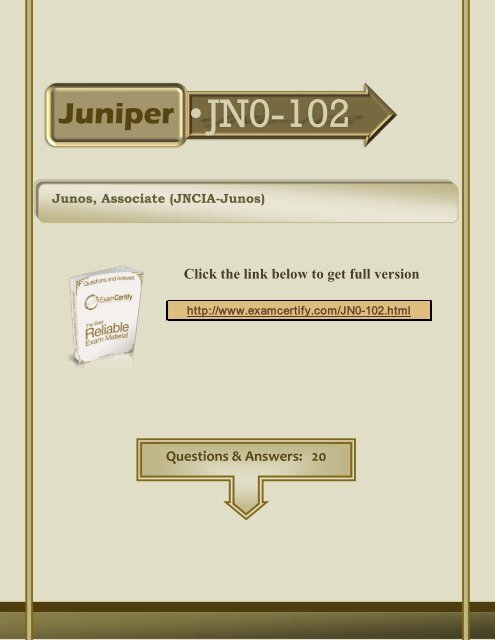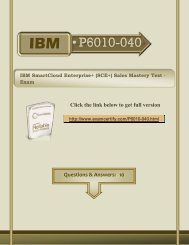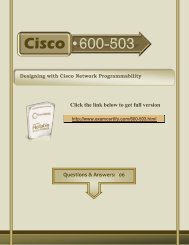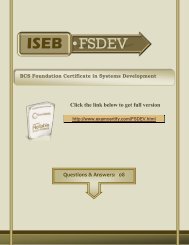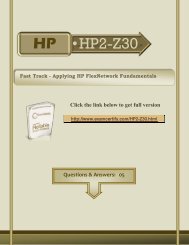•JN0-102
Create successful ePaper yourself
Turn your PDF publications into a flip-book with our unique Google optimized e-Paper software.
Juniper<br />
<strong>•JN0</strong>-<strong>102</strong><br />
Junos, Associate (JNCIA-Junos)<br />
Click the link below to get full version<br />
http://www.examcertify.com/JN0-<strong>102</strong>.html<br />
Questions & Answers: 20
Question: 1<br />
The IP address 10.1.1.1 belongs to which class of IP address space?<br />
A. Class A<br />
B. Class B<br />
C. Class C<br />
D. Class D<br />
Answer: A<br />
Question: 2<br />
For the interface ge-1/2/3.4, what does "ge" represent?<br />
A. SONET/SDH<br />
B. Gigabit Ethernet<br />
C. Aggregated Ethernet<br />
D. GRE<br />
Answer: B<br />
Question: 3<br />
Which word starts a command to display the operational status of a Junos device?<br />
A. put<br />
B. set<br />
C. show<br />
D. get<br />
Answer: C<br />
Question: 4<br />
http://www.examcertify.com/JN0-<strong>102</strong>.html Page 2
Which command prompt indicates that you are in operational mode?<br />
A. user@router&<br />
B. user@router#<br />
C. user@router%<br />
D. user@router><br />
Answer: D<br />
Question: 5<br />
What is the decimal equivalent of 00000100?<br />
A. 2<br />
B. 4<br />
C. 9<br />
D. 12<br />
Answer: B<br />
Question: 6<br />
What is a valid IPv6 address?<br />
A. 00:05:85:23:45:67<br />
B. 127.0.0.1<br />
C. 2001:0db8:3000:2215:0000:0000:aaaa:1111<br />
D. 49.0001.0192.0168.1001.00<br />
Answer: C<br />
Question: 7<br />
Which simplified IPv6 address is the same as the IP address<br />
2001:0000:1000:0000:0000:cbff:0020:0001/64?<br />
A. 2001::1::cbff:2:0001/64<br />
B. 2001::1000::cbff:20:1/64<br />
http://www.examcertify.com/JN0-<strong>102</strong>.html Page 3
C. 2001:0:1000::cbff:20:1/64<br />
D. 2001:0:1:0:0:cbff:2:1/64<br />
Answer: C<br />
Question: 8<br />
What are three characteristics of UDP? (Choose three.)<br />
A. UDP is faster than TCP.<br />
B. UDP operates at the Transport Layer.<br />
C. UDP is connection-oriented.<br />
D. UDP data is sent best-effort.<br />
E. UDP is more reliable than TCP.<br />
Answer: A, B, D<br />
Question: 9<br />
Which layer in the OSI model is responsible for translating frames into bits?<br />
A. Application Layer<br />
B. Presentation Layer<br />
C. Data Link Layer<br />
D. Physical Layer<br />
Answer: C<br />
Question: 10<br />
Which layer in the TCP/IP model is responsible for delivering packets to their destination?<br />
A. Application Layer<br />
B. Transport Layer<br />
C. Internet Layer<br />
D. Network Access Layer<br />
http://www.examcertify.com/JN0-<strong>102</strong>.html Page 4
Answer: C<br />
Question: 11<br />
Why is IPv6 packet processing more effective than IPv4 packet processing?<br />
A. fixed header size<br />
B. smaller header size<br />
C. fewer header fields<br />
D. variable header size<br />
Answer: A<br />
Question: 12<br />
A user opens a webpage that requires the transmission of packets from the Web server to the<br />
client's browser. The packets transmitted from the Web server to the client exceed the smallest MTU<br />
value on the communications path.<br />
Which two protocol functions allow this type of communication? (Choose two.)<br />
A. packet segmentation<br />
B. serialized checking<br />
C. packet sequencing<br />
D. parallel checking<br />
Answer: A, C<br />
Question: 13<br />
Which two statements are true about TCP communication? (Choose two.)<br />
A. The receiver acknowledges the final packet in each communications stream.<br />
B. The receiver adds sequencing numbers to the packets received.<br />
C. The sender adds sequencing numbers to the packets it sends.<br />
D. The receiver acknowledges each packet it receives from the sending device.<br />
Answer: A, C<br />
http://www.examcertify.com/JN0-<strong>102</strong>.html Page 5
Question: 14<br />
Which two statements are true about optical networks? (Choose two.)<br />
A. SONET and SDH both use time-division multiplexing.<br />
B. An optical transport network system uses time-division multiplexing.<br />
C. SONET and SDH both use wavelength-division multiplexing.<br />
D. An optical transport network system uses wavelength-division multiplexing.<br />
Answer: A, D<br />
Question: 15<br />
At which layer of the OSI model does error checking occur with IPv6?<br />
A. Layer 2<br />
B. Layer 3<br />
C. Layer 4<br />
D. Layer 7<br />
Answer: C<br />
Question: 16<br />
Which statement is correct regarding IPv6 addresses?<br />
A. An IPv6 address consists of 128 bits separated into eight 16-bit hexadecimal sections.<br />
B. An IPv6 address consists of 64 bits separated into four 16-bit hexadecimal sections.<br />
C. An IPv6 address consists of 128 bits separated into sixteen 8-bit hexadecimal sections.<br />
D. An IPv6 address consists of 64 bits separated into eight 8-bit hexadecimal sections.<br />
Answer: A<br />
Question: 17<br />
Which two statements about MPLS label-switched paths (LSPs) are true? (Choose two.)<br />
http://www.examcertify.com/JN0-<strong>102</strong>.html Page 6
A. LSPs are bidirectional.<br />
B. LSPs are unidirectional.<br />
C. LSPs must follow the IGP's shortest path.<br />
D. LSPs can follow paths other than the IGP's shortest path.<br />
Answer: B, D<br />
Question: 18<br />
What are two ways that packet fragmentation is handled differently between IPv6 and IPv4?<br />
(Choose two.)<br />
A. End hosts determine the path MTU for IPv6.<br />
B. End hosts determine the path MTU for IPv4.<br />
C. Packet fragmentation occurs at intermediate nodes for IPv4.<br />
D. Packet fragmentation occurs at intermediate nodes for IPv6.<br />
Answer: A, C<br />
Question: 19<br />
-- Exhibit --<br />
user@router> show route protocol static<br />
inet.0: 15 destinations, 15 routes (15 active, 0 holddown, 0 hidden)<br />
+ = Active Route, - = Last Active, * = Both<br />
99.0.0.0/17 *[Static/5] 00:00:11<br />
>to 10.1.1.2 via ge-0/0/1.0<br />
99.0.0.0/19 *[Static/5] 00:00:11<br />
>to 10.1.2.2 via ge-0/0/2.0<br />
99.0.0.0/24 *[Static/5] 00:00:11<br />
>to 10.1.3.2 via ge-0/0/3.0<br />
99.0.0.0/26 *[Static/5] 00:00:11<br />
>to 10.1.4.2 via ge-0/0/4.0<br />
-- Exhibit --<br />
In the exhibit, there are four static routes that route traffic through different interfaces.<br />
Which interface does the router use if traffic is sent to the 99.0.0.1 destination?<br />
A. ge-0/0/1<br />
B. ge-0/0/2<br />
C. ge-0/0/3<br />
http://www.examcertify.com/JN0-<strong>102</strong>.html Page 7
D. ge-0/0/4<br />
Answer: D<br />
Question: 20<br />
In dotted decimal notation, what is the equivalent of 11010101 01000010 01111111 11000010?<br />
A. 213.66.127.194<br />
B. 214.66.128.195<br />
C. 212.64.143.194<br />
D. 213.66.111.194<br />
Answer: A<br />
http://www.examcertify.com/JN0-<strong>102</strong>.html Page 8
Juniper<br />
<strong>•JN0</strong>-<strong>102</strong><br />
Junos, Associate (JNCIA-Junos)<br />
Click the link below to get full version<br />
http://www.examcertify.com/JN0-<strong>102</strong>.html<br />
Latest tests<br />
70-331 70-332<br />
LOT-951 70-321<br />
HP2-T25<br />
HP2-T26<br />
70-341 70-342<br />
70-411 70-410<br />
70-336 PEGACLSA_62V2<br />
70-337 C_TADM51702<br />
HP0-J54 00M-662<br />
70-689 000-N37<br />
70-480 HP0-J59<br />
http://www.examcertify.com/JN0-<strong>102</strong>.html Page 9


